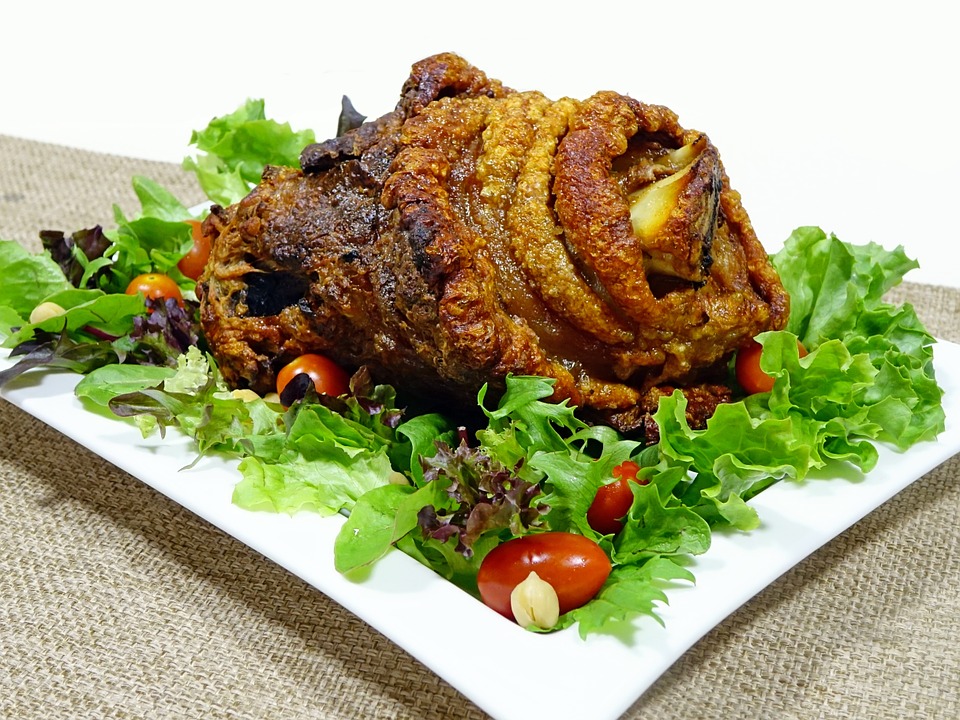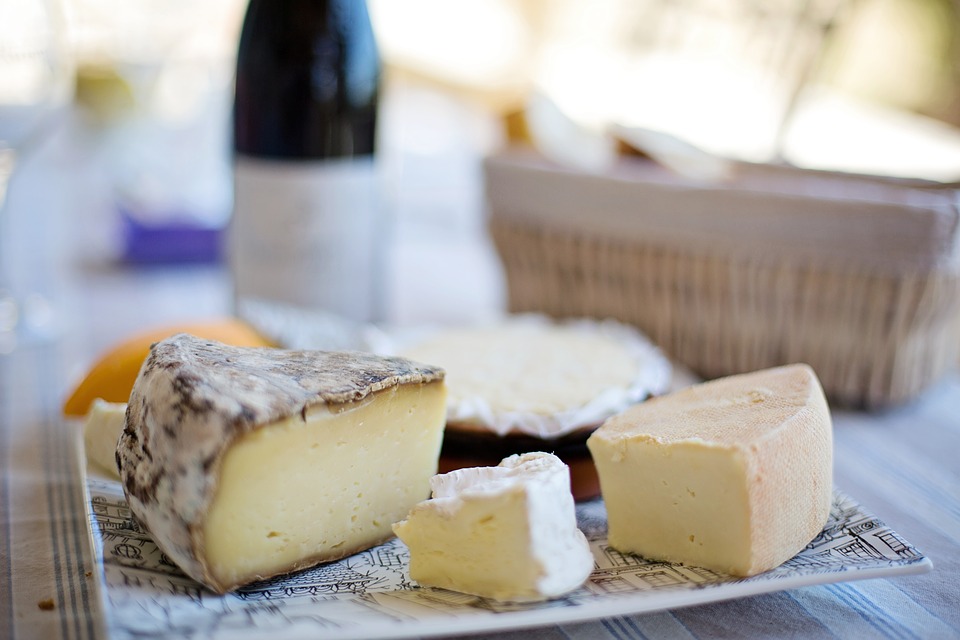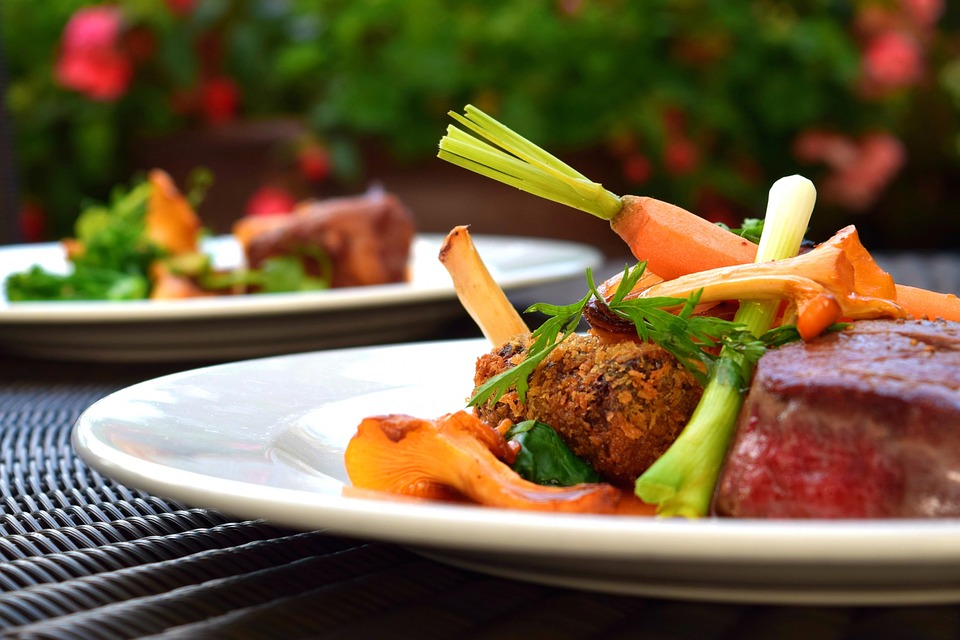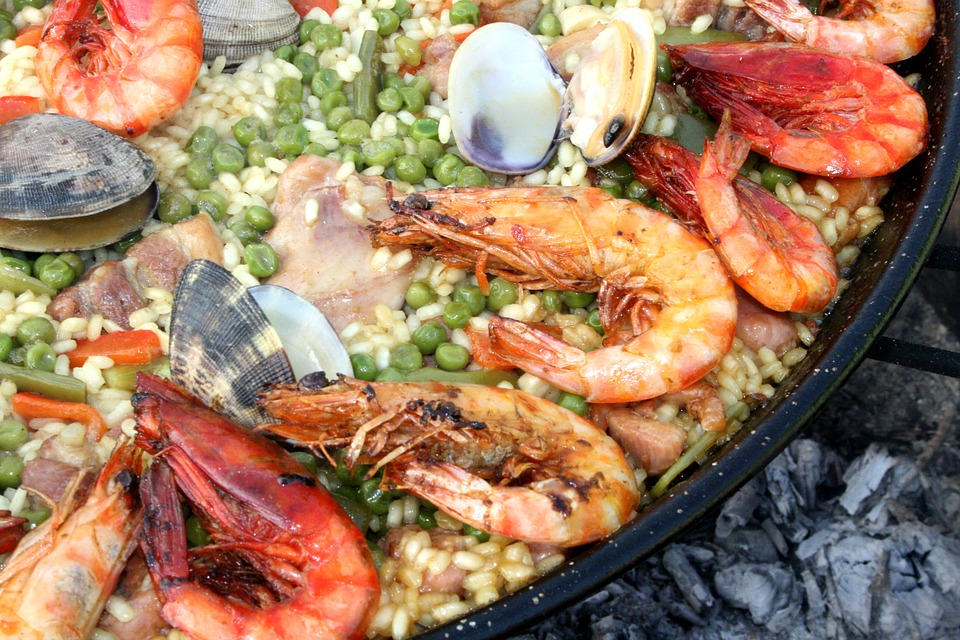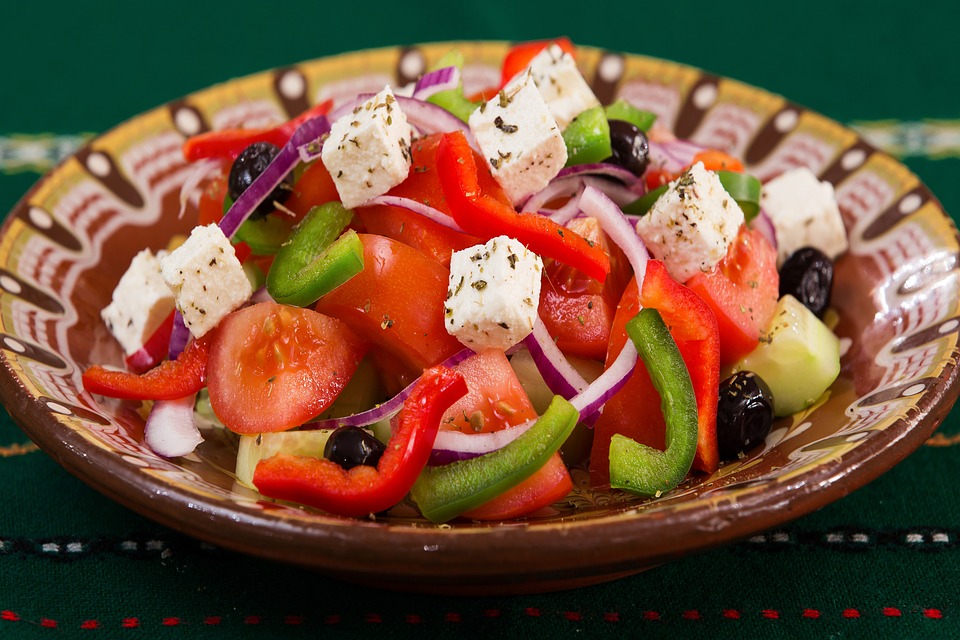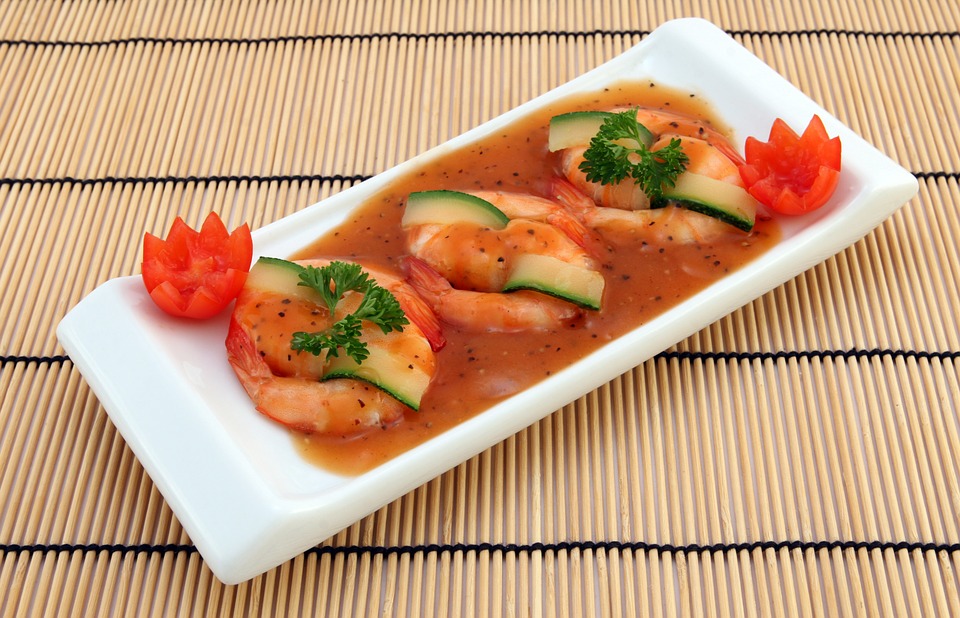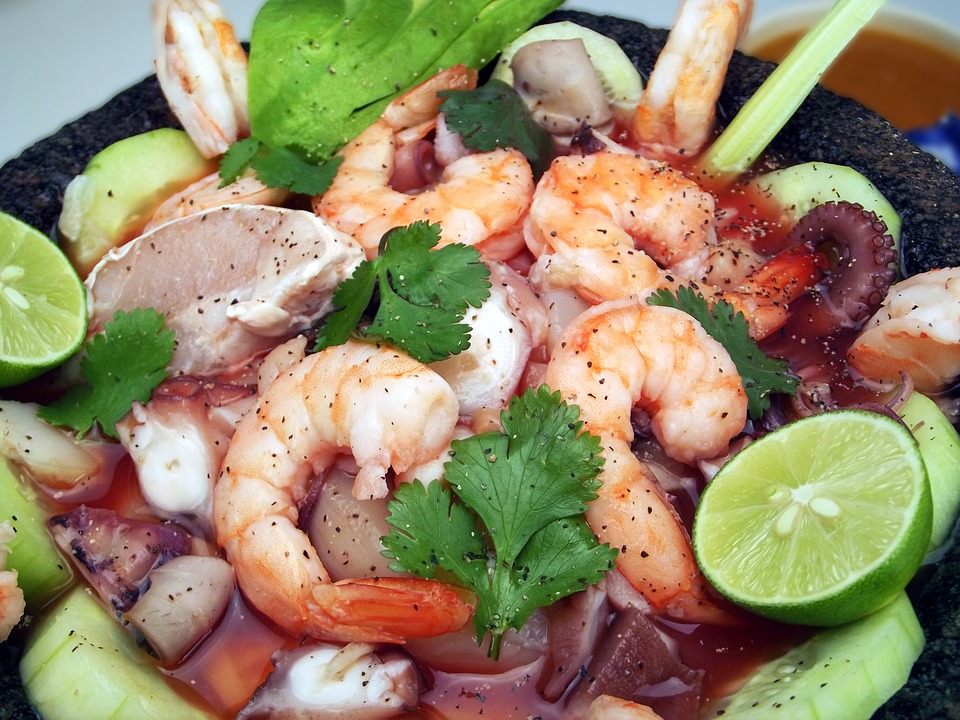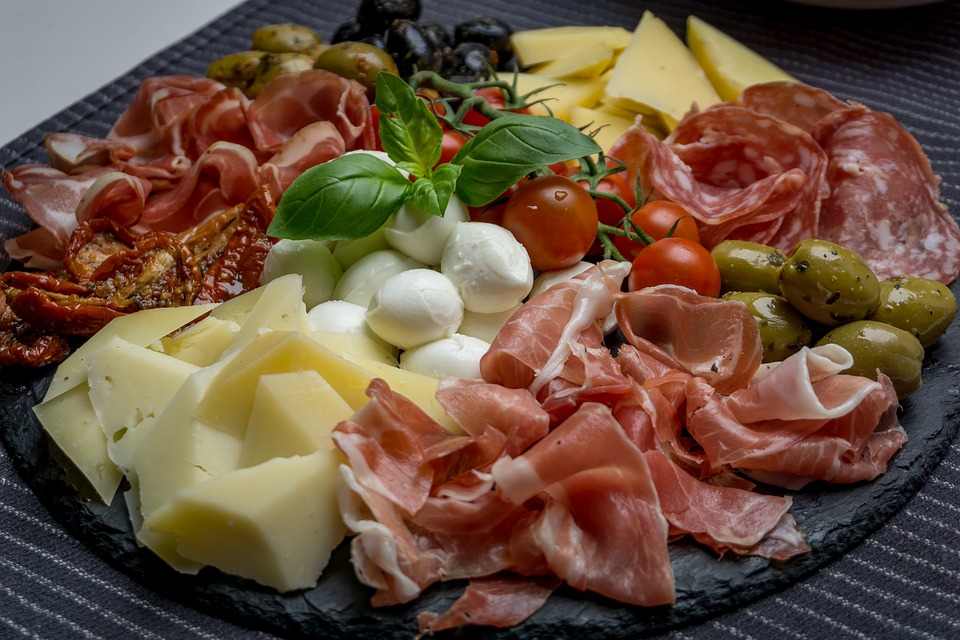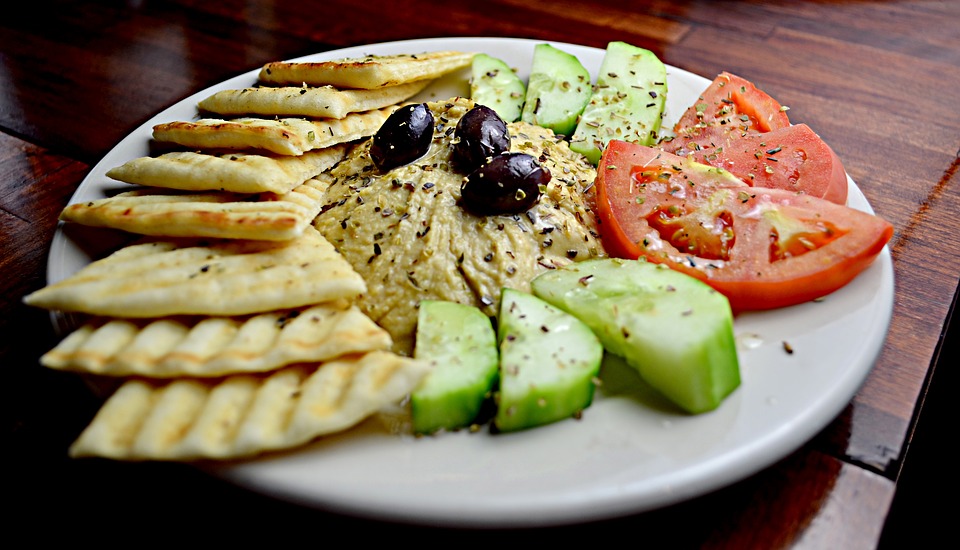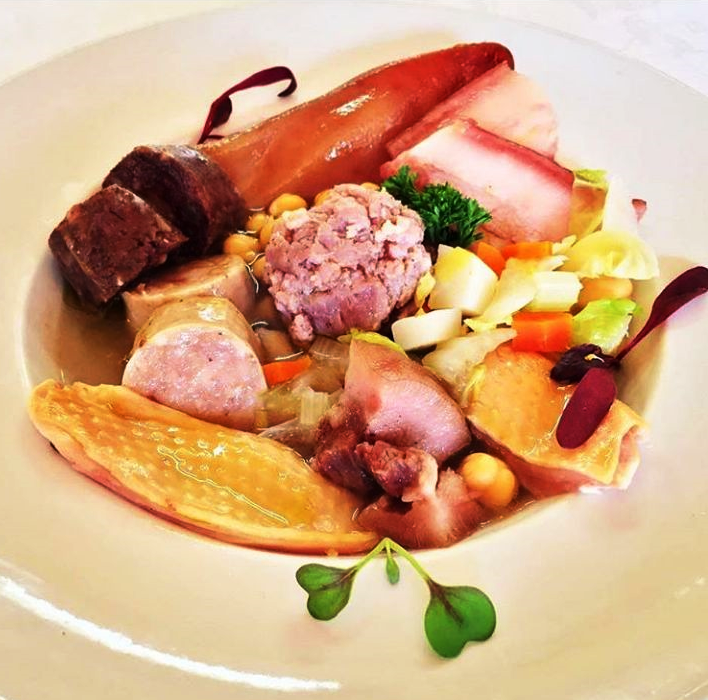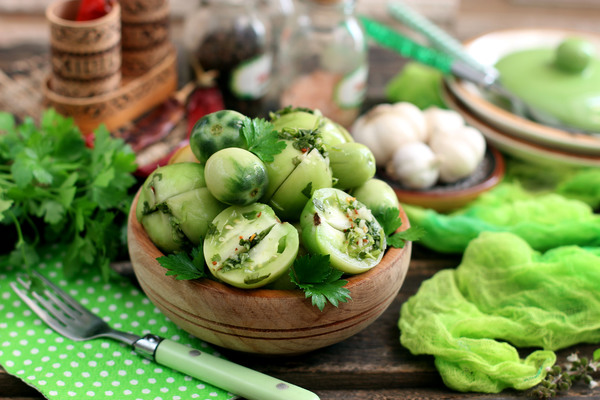Catalan cuisine is part of Mediterranean cuisine and its typical example. Most often references are made to the food of Catalonia and Northern Catalonia, and occasionally Andorra but some contemporary authors like Josep Pla, Jaume Fàbrega, Eliana Thibaut i Comalada, Ferran Agulló and the English-language writer, Colman Andrews, talk about shared gastronomy throughout the Catalan cultural area, including the Valencian Community, Balearic Islands, La Franja and Andorra, and therefore it would be best referred to as the cuisine of the Catalan Countries.
Other authors consider, however, that there are different Valencian and Balearic cuisine. On the other hand, the governments of the Valencian Community and the Balearic Islands, do not support this interpretation, although they do not declare otherwise, while the Generalitat de Catalunya gives various views depending on the source consulted.
On the other hand, it is worth mentioning the local presence of, to varying degrees, different cuisines, such as xurra (from the comarques xurres of Valencia and Canal de Navarrés), castellana (from Baix Segura, the Vall de Cofrents and La Plana from Utiel, as well as parts of Alto Vinalopó, Vinalopó Mitjà) and Occitan cuisine from the Vall d’Aran and Fenolleda. It should be also added that Catalan cuisine has left its mark in Murcia thanks to its historically Catalan population and the historical contact between Murcia and Valencia.
What we eat or drink is the result of the past and all those civilizations that have passed through these territories have left a mark in the cuisine of the Catalan Countries. Current Catalan cuisine has characteristics left by the Iberians, Phoenicians, Greeks, Romans, Jews and Arabs. There are also some influences from French and Italian cuisine. The discovery of America brought new ingredients, which are now staples, such as potatoes and tomatoes furthermore the new American cuisine has also brought about changes to traditional kitchen.
In the Baix Llobregat beer was already prepared in the Neolithic. The arrival of the Greeks, in Empúries, and the Phoenicians, in the Balearic Islands and in the Valencian Country, marked a major change in habits. Before their arrival there was neither olive oil nor wine.
From 5,000 years before Christ, the food was based on spelled type of wheat, barley, millet, maize or corn, legumes (they were eaten fresh and dried), fruits, fish, lamb, goat and pork. In some parts of the Pyrenees, horses and even dogs were eaten.
The Iberians already made beer and wine that they sold to the Phoenicians, and in Cerdanya they made exquisite hams praised by the Romans, ,«Cerretana mihi fiat vel missa licebit / de Menapis; lauti de petasone rorent»(«I hope they serve me the ham of the country of the Ceretans and not give me that of the country of menapis, and that the starving devour the thigh»). They stored a lot of grain that was eaten in the form of bread and flour.
Greco-Roman cuisine
Greek chefs were famous and enjoyed a high social status. It is possible to attribute to the presence of the Greeks the cultivation and use of foods that are now essential, the Romans ended up reinforcing this tendency further. The Greeks introduced or strengthened the cultivation of almond, the production of wine (from autochthonous strains) and the olive from wild olive (through grafts), a plant deeply rooted in the Catalan Countries.
Plini said that “the Laietana vineyards (Barcelonès and Maresme) are famous for the quantity of wine that they give, but those of Tarragona and those of Laura for their finesse”.
Esabeche was an area of Roman cuisine including fish casseroles with raisins, barley cooked with juice, Vallespir barley escudella, green sauces for fish made in the Balearic Islands, several roasts, fried and boiled dishes that are not so common in today’s cuisine. Already than they were using grills, casseroles, soups, pots and suquets to cook fish. The Catalan word of paella comes from the Latin patella.
In the Roman villas (antecedents of the farmhouses) wine, olive oil, vinegar, honey, cheeses, cold meats, hams, salted or preserved in vinegar fish, dried fruit, etc. were prepared.
Some current sweets inspired by Romans are the Santa Teresa toast covered with honey, cream or white cheese, fried milk, pine nuts, raisins, dates; or semolina with pine nuts, almonds and sweet wine; panellets, coca with peaches, cheese bunuelos, flaons of fresh cheese and type of nougat from Xixona.
Middle Ages
The Arab and Jewish legacy is important in the Iberian Peninsula. Some foods originating from the times of Muslim occupation are the sauce of xató (romesco), salvitxada, all-i-pebre and salmorreta. According to Corominas, both the words “xató” and “romesco” come from the Mozarabic.
The Arabs introduced products which are now considered basics such as artichoke, eggplant, chickpeas, sugar, couscous and noodles, spices (such as coriander, basil, saffron and cumin) and Gastronomic techniques, such as distillation of alcohol, which, despite the Koranic prohibition, often had medical uses.
Certain slow cooking methods of meat and vegetables in casserole pot can be compared to those of both Arabic and Jewish stews. Some of today’s desserts and pastries are also reminiscent of the Jewish tradition, which is also widely recognized among Muslims.
As a consequence of the intercultural clash, there was also a certain desire to reject these two cultures (or perhaps a greater need to reassure against the difference, or even openly display the Christian religion in the face of persecutions of a political nature) on the part of the Christians, that was translated in the high consumption of pork, that has survived till today with the great liking of the dried sausages – embotits, and the preference of this meat over beef.
Very soon these preparations became immortalized in recipe books, the first of which is the Llibre de Sent Soví, from the year 1324, which compiles more than two hundred medieval recipes.
15th Century Onwards
It is with the mediterranean policy of the Crown of Aragon – essentially a policy of commercial dominance – that ports and markets got filled with new ingredients and the noble and bourgeois tables experimented with new recipes from far and near.
The new contact between Europe and the Americas, in the 15th century, did not provide new recipes or cultural influence right away, but over time new products were introduced, such as chocolate, potatoes and most importantly tomatoes, an ingredient that according to Colman Andrews is one of the most essentials in current Catalan cuisine.
The use of tomatoes does not enter the kitchen of the Catalan Countries until at least the 17th century and is not documented until the 18th century.
In the 16th century bread was still a basic element of any meal. Meat was very prized, especially ram meat (lamb). At the time, meat was roasted or cooked. The first written references to the use of dried cod in Catalan cuisine are also from the 16th century, cod was brought from Portugal through the Basques, across the Pyrenees. It was typical to eat a lot of vegetables and season it a lot. The fruit was also valued highly, especially melon and grapes, as well as nuts. The usual drinks were red wine and water, in any case always fresh. In this century, the fish was prepared in suquet with vegetables, oil and pepper. Also at this time cream became a fashionable, if it had to be sweetened, it was done with honey or sugar.
In the 19th century, the bourgeoisie opted for opulent preparations and menus, which never came to become popular or rooted in, often inspired by bourgeois French cuisine, which despised traditional and homemade cuisines such as Catalan, Italian and Occitan. On the other hand, at the inns, Catalan cuisine was still accessible to everyone, innovated and improved according to the tastes of its customers, who copied some of the dishes, such as cod a la llauna, at home (mostly on holidays). The traditions or customs like the paella eaten on Thursdays are also owed to them. Furthermore, it is in this century when the pa amb tomàquet (bread with tomato) appears for the first time in a written reference.
Mediterranean cuisine
The different cuisines are never separated from one another and there are usually as many dishes shared as unique. One of the reasons to consider Catalan cuisine as part of a Mediterranean is the large number of basic elements that it shares with other cuisines such as Italian, Occitan and Spanish. One reason to consider Catalan cuisine as independent of these three is the numerous unity of some recipes all over the Catalan Countries (the esqueixada, arròs a banda or the escalivada are found with various names but with similar recipes), or the use of a single name for a broad culinary concept (as in the case of coca).
Another consideration is that, although many dishes common to the three countries of Catalan culture date from after the reconquest (such as samfaina and sofregit, since tomato was introduced in the 15th century) the cultural relations and especially commercial ones between Catalonia, the Valencian Country, the Balearic Islands, and also with the rest of the Western Mediterranean did not stop there, instead there was a more or less continuous exchange based on the ports and markets and meetings between fishermen of the Catalan sea. The level of popularization of certain coastal dishes such as paella, allioli or samfaina, easy to find even in the interior, is much more remarkable than any interior dish, such as trinxat or girella, which even in the 21st century are not habitual outside the Catalan Pyrenees.
Speaking of tomatoes, their acceptance throughout the Catalan Countries, without exception, indicates a high level of culinary interrelation in the Mediterranean of the Late Middle Ages, despite the fact that the tomato was rejected by the rich and loved by the poor. Thus, the tomato, despite being subsequent to the reconquest and repopulation of the Islands and the Valencian Country, became essential in the Mediterranean cuisine and especially in the cuisine of all the Catalan Countries.
Basic ingredients
● Condiments: Olive oil, salt, sugar, garlic, pepper, red pepper, almonds, parsley, saffron, cinnamon, rosemary, thyme, chocolate (unlike Occitan cuisine, Catalan cuisine traditionally does not use as many spices).
● Vegetables: Tomato, onion, calçot, cabbage, pepper, potato, sweet potato, eggplant, zucchini, cabbage, carrots, chards, artichoke, squash.
● Legumes: broad beans, green beans, lentil, chufa, chickpeas, peas.
● Cereals: Rice, maize, flour and wheat semolina.
● Fruits: Orange, lime, grape, peach, pear, cherry, medlar.
● Fish: Cod, eel, tuna, anchovies, prawns and seafood of all kinds.
● Meat, poultry and game: Pork, lamb, chicken, rabbit, snail.
● Others: mushrooms, truffles.
Elements and typical dishes
We can talk about three types of Catalan cuisine: the shared one, the original one and the unique one. The shared one is that which is shared with the rest of the Mediterranean. The original one was invented in the Catalan Countries, but is now present in the cuisine of other countries. The unique one includes those dishes or food that have not transferred out from the Catalan Countries.
Common dishes in the Mediterranean or in the world
● Paella – A dish that originates in the Ribera del Xúquer river, Valencia, and has spread to other regions, to most of the Catalan comarques, the Balearic Islands and Murcia from at least the 16th century according to Francisco de Paula Martí; also has a documented historical presence in Occitania (Nice). Nowadays it is offered in a large number of Spanish restaurants thanks to the mass tourism, and lately in other parts of the world: in Australia, the Philippines, Latin America (especially Mexico and Venezuela), the United States, and Western Europe. In France it has inspired paëlla, a plate of rice cooked with turmeric, saffron and chorizo.
● Coca – present all over the Mediterranean: in Italy as a pizza, in Greece, in Turkey as pide, in Armenia as lahmacun, in the Arab world in general just as bread.
● Allioli – present in Spain, France and Italy; It was probably introduced to Catalonia from outside.
● Samfaina, xanfaina, tomacat or mullador – present all over the world and deeply rooted in the Mediterranean, in English and French it is called Ratatouille, an almost identical version from Provence and marketed all over France. In Castilie it is called pisto and in southern Italy, the Neapolitan sauce is very similar to it.
● Sofregit – present in the western Mediterranean, as soffritto (Italy), sofrito (Spain), refogado (Portugal), etc.
● Cava – present in La Rioja and Extremadura, in the French region of Champagne as champagne , in the rest of France as crémant and in Italy as a spumante.
● Bunyols – present in the southern Mediterranean, they were borrowed from the Arabs.
● Bunyols de bacallà (Cod fritters) – present in Spain and Portugal. Present also in some Central American countries as “accras” of cod which are almost the same, but with chili peppers added.
● Bacallà amb patates (Cod with potatoes), also present in other cuisines with different names such as: borrida, sacsacollons, bacalhau cozido, ‘a la grandi colloni, etc.
● Chicken with samfaina, and variants depending on the regions: chicken with pepper and tomato, chicken with tip (Girona), chicken a la Catalana (northern Catalonia), etc. There is also a similar version in the Basque Country.
● Partridges with cabbage, or in cabbage farcellets (bundles) and cooked on a frying pan. Typical of the Catalan Pyrenees, Occitania and some places in the north of France.
● Salad – present around the world and deeply rooted in the Mediterranean.
● Embotit (llonganissa, chorizo, etc.) – present in Spain, France (saucisson) and Italy (salame or luganega in Milanese). In Germany there is a great variety of deer meat sausages and in the Muslim countries they are made with turkey meat or lamb.
● Cured ham – present in Spain, France, Basque Country and Italy (prosciutto).
● Botifarra crua (en. raw sausage) – present in the world and deeply rooted in the Mediterranean.
● Broth – present everywhere in the world.
● Empanada – present everywhere in the world.
● Buñuelos: sweet and savoury – the sweet ones are present around the world while savoury ones are made in Mediterranean countries.
● Meatballs or Boles de picolat (typical ones from North Catalonia, in catalan also called pilota) – present throughout the world.
● Mona de Pasqua – present in Spain, France and Italy (colomba di Pasqua) it is a traditional Easter cake often decorated with eggs.
● Fish soup or Bullinada – present in Occitania (Marseille) under the name of Bolhabaissa.
● Coca de dacsa – present in Mexico as tortilla and in the Basque Country as talo, among others.
● Mató (or Brull, Brossat, recuit) – present in Spain as Requesón, in Provence comme brousse and in Italy Ricotta is very similar to it.
● Ollada (or Putxero) – common around the world it is a type of stew made in casserole.
● Torró de Xixona, Alacant and Agramunt – a soft variety (nougat) is present in Occitania (Montélimar) and in Italy, and another even softer variety (halva) often with pistachios is found in the countries of the south of the Mediterranean.
● Bunyeta – various similar versions are made in many places in the Mediterranean.
● Panellets – they exist in Valladolid and other places of Castile with the name of empiñonadas. In Andalusia, the piñonates are very similar.
● Orelletes – Also present in Castile as orejeulas and acute regions of France as oreillettes or bugnes. Its name and its shape changes in each region.
● Carquinyolis or rosegons – well rooted in Aragon, of probable Arab origin.
● Flaó – dishes with the same name and similar preparations can be found all over the Mediterranean.
● Rice with milk – present all over the Mediterranean.
● Cargols a la llauna – snails are common in France, where they are prepared without sauce, only filled with butter, garlic and parsley.
● Arrop (arruix) or mostillo – sweet pastries based on must, they must be of Arab origin and are eaten in La Mancha, Murcia and Aragon.
● Llet merengada – cold and flavored milk, sometimes thick as in the case of Turkish Ayran, it is common in the Mediterranean to drink it against dehydration in the summer, as it refreshes and replenishes the lost nutrients. In Catalan Countries, it appears as cream or rice with milk, merengada has cinnamon and lemon flavour. It is sold in lletries or granjas, orxateria and ice cream parlors.
● Wine of Catalonia, Wine of the Valencian Country, and Wine of Roussillon – Wine is a worldwide product with some early presence in the Mediterranean.
Dishes that originated in the Catalan Countries and are now present in other countries
● Aigua de València – in English Buck’s fizz, although the two have developed separately.
● Crema catalana – present throughout Europe, in addition to French flam.
● Ensaïmada – present commercially in Spain.
● Escalivada – present in Spain as escalibada.
● Spinach with raisins and pine nuts – present in Spain as spinach “a la Catalana”.
● Mayonnaise – present throughout the world. There is a doubt if it comes from Maó or Mayenne, France.
● Partridge a la Catalana, native to northern Catalonia and spread to the rest of France.
● Sobrassada – is made in some parts of Spain, but without the denominacion de origin, Mallorca.
● Chocolatada – present in Spain. In Italy the melted chocolate is also made although it is more liquid.
Unique dishes to the Catalan Countries
● Embotits: secallona, fuet, botifarra, botifarró, carn-i-xulla, bull and girella (this last one is common, also, in the Aragonese Ribagorça).
● Sauces: anchovada, olivada, salvitxada, xató, balandra and romesco
● Salads: Esqueixada or Esgarrat; Xató, escarole salad, crashed cod and romesco sauce; Empedrat, bean salad, diced tomato, tuna and olives; Catalan salad with very fresh lettuce and fine slices of the best local sausages.
● Rice: Rice with crust, rice with beans and turnips, arròs a banda, baked rice, arròs a la bruta, casserole rice, arroz caldoso, black rice, dark rice in the Empordà way, rice Parellada or a la gandula, cod rice, rabbit rice. However, in other cuisines there are similar dishes to casserole rice, such as risotto in Italy.
● Wheat pasta: Fideuà or fideuada, Sant Esteve cannelloni, casserole noodles.
● Meat: Trinxat, chopped cabbage sauté on a pan with sausage or bacon; Liver with onions, it is a version of traditional Central European dish with added garlic; Fricandó, perhaps started as a variation of the Occitan one, but these are two very different dishes, Catalan uses meat cut into very thin sheets and not a large piece of whole meat, for example; rabbit with allioli; or chicken with lobster, prawn or shrimp; rabbit or chicken with chocolate, sometimes also with dried apricots, prunes and pine nuts; etc
● Fish: Cod with samfaina, or cod with tomato, or with peppers or onions. Although all these dishes always have onion, tomato, pepper, etc.
● Desserts: Menjablanc (en. blancmange) – although the recipe appears historically in many parts of Europe; mató de monja or de Pedralbes; pears of Lleida.
● Sweet pastries: Fartons de Alboraia, Horta Nord; Xuixo inspired by French, original from Girona; Casques typical of the Kings Day in the Valencian Community and Mallorca.
● Beverages: Orxata, Ibiza Herbs, Pomada, Palo, Mistela produced from Sauces in Elche, Ratafia.
● Pa amb toàquet (Bread with tomato)
● Escudella, typical Catalan soup.
● Calçotada: Calçots with sauce accompanied by bread with tomato and other vegetables and grilled meats.
● Fricandó, perhaps started as a version of Occitan one, but they are two different dishes, the Catalan one, for example, uses meat cut into very thin sheets and not a large piece of whole meat
Variety in Catalan cuisine
Catalan cuisine and, by extension, the culinary tradition of the Catalan Countries, is a kitchen rooted in the use of local and seasonal products. Consequently, there is an outstanding regionalization according to the type of land: coastal or mountainous.
● The coastal regions base their gastronomy on seafood, fish, rice, vegetables, such as tomatoes, aubergines and peppers – legumes and citrus fruits. Instead, meat and poultry – almost always chicken and pork – are often limited as mere condiment.
In spite of the abundance of embotits, the fact is that neither meat nor fish are almost never presented as the main elements of the coastal and lowland dishes. This could be due to the relatively high cost of meat and fish that makes it necessary to combine it with cereals, rice and bread that give weight to food. It is a custom that helped to limit fat content in Catalan cuisine. The importance of these considerations should not be underestimated, since it is the origin of the farmer’s or fisherman’s household who has most marked the catalan cuisine.
● The lowland regions, halfway between the mountains and the sea, generally follow the coastal pattern but with an increase of casserole dishes and more use of legumes. Meat, usually pork, often replaces the fish.
● The high mountain regions, on the other hand, seem to dispense with fish and seafood, and the use of rice is also less common. Instead, the use of meat, poultry, game, cereal, legumes, vegetables such as potatoes, carrots and onions, mushrooms and fruits of the forest increases considerably. Lamb and sausages are abundant. Gironella, a typical lamb embotit in the Pyrenees, breaks the typical use of pork prevailing in the lowlands.
It should be noted that the contemporary era has contributed to partly blur these distinctions. The generalization of certain dishes such as paella or fish suquet has brought rice and fish to areas of the interior that never used them before. Also, mushrooms and sausages from the Pyrenees reached markets all over the coast where they were not commonly eaten before. On the other hand, modernity has labeled “typical” dishes that were previously considered foreign, innovative or only regional, and introduced many new culinary features, previously unknown and now strongly rooted in the culture, such as the cannelloni eaten on St. Stephen’s day.
However, this duality of the sea and the mountains, often close to each other, is responsible for the most remarkable element of Catalan cuisine, dishes that mix fish and meat, called “from the sea and the mountain”, such as coca with fish and llonganissa. Equally interesting are the dishes of the West that mix meat and fruit.
The variety is inherent in home cuisine that is still alive and going strong. If the stereotype says that the coast is frying and the interior roasts, in the Catalan Communities,, both coastal and inland, almost all cooking techniques are used: the bullit is boiled, the ollada is slow cooked, the samfaina is gentle fried, the frit is fried, the rice is cooked in the oven or on the stove, the escalivada is roasted.
If we look for a unifying element, it is clearly the connection it has to the Mediterranean diet. It is a cuisine very faithful to the typical Mediterranean ingredients – rice, olive oil, vegetables, legumes, fruit, cereals, fish, meat and poultry, with a preference for fresh products of the season. The most popular preserves are the anchovies in salt, cod and embotits. If the Occitan and Italian cuisines include elements that are not really Mediterranean such as cream, fresh cream and butter, these condiments are almost totally absent from home cooking of the Catalan Countries, where olive oil has an absolute preference over butter, with the exception of l ‘Alt Pirineu. Another notable absence is that of cheeses. There are only six renowned cheeses, that of Maó, Cerdanya and Alt Urgell, Llenguat and Tupí del Pallars, Tovalló typical of Valencia and the surrounding area and the mató or brossat that is common everywhere, compared to the hundreds offered in Italy and Occitania. The consumption of milk and dairy products is not very strong outside the Pyrenees.
Another unifying and typical element of the Catalan gastronomy is the picada (which is a type of sauce). A fish soup can be from any country in the Mediterranean, but if it has picada it is a Catalan recipe.
Talking about typical dishes, they are usually described in motifs, since the names, ingredients and ways to prepare each dish vary from region to region. Only the most modern cuisine, which undoes the bond between food and land, is able to create a truly homogenous cuisine. Instead, it is in the huge variety of recipes available for coca that one can find the richness of Catalan cuisine.
Catalan, Balearic and Valencian chefs
Some of the most outstanding chefs from the Catalan Countries include:
● Ferran Adrià, chef of El Bulli, the best restaurant in the world, closed in 2011. His cuisine is based on the traditional flavours of traditional Catalan cuisine but joined with new techniques, such as deconstruction, foams made with siphon, spherification, and new ways of presentation. He is the first cook in the world to speak of creation and creative cuisine.
● Carme Ruscalleda i Serra, chef from the restaurants of Sant Pau in Sant Pol de Mar and in Tokyo. She is the only one in Spain to achieve five stars of the Michelin Guide and has also written books with simple Catalan recipes that have been translated into four languages. Carme Ruscalleda incorporates new techniques and products, like jellyfish, into traditional Catalan cuisine and uses Mediterranean herbs in many ways.
● Joan Roca, chef of El Celler de Can Roca in Girona, considered fifth best in the world. He unveils traditional Catalan cuisine, bringing to it new old techniques such as distillation of food (which in fact was already used in the Middle Ages) and perfuming (which is based on something as old as adding a branch of rosemary or other grass while braising to perfume the meat).
● Santi Santamaria, owner of the restaurant El Racó de Can Fabes is, like Ferran Adrià or Carme Ruscalleda, a regular member of the mass media. He advocated preservation of tradition and had differences with Ferran Adrià because of their various views of the kitchen. He died in February 2011.
● Josep Lladonosa i Giró, a researcher of traditional Catalan cuisine, he has recovered old recipes, especially the recipes of rice dishes, which he has collected in a book translated into English, French and German. For fifty years he was a chef of the emblematic restaurant of Barcelona, Set Portes.
● Didier Banyols, from Perpignan, he got two Michelin stars in the restaurant Les Feuillants in Ceret.
● Águeda Vadell Pons, a chef in a restaurant Ca n’Aguedet of Es Mercadal, one of the most emblematic and considered one of the best in Menorca, she collaborates in the compilation and dissemination of traditional Menorcan recipes.
● Other chefs: Ignasi Domènech i Puigcercós, Mariona Quadrada, Maria Esteva Ferrer, Paquita Reixac, etc.
Gastronomists, researchers and propagators of the cuisine of the Catalan Countries
Some researchers and popularizers of recipes and culinary culture are Ferran Agulló, Josep Lladonosa i Giró, Nèstor Luján Fernández, Eliana Thibaut and Comalada, Jaume Fàbrega, Xavier Domingo, Luis Bettonica, etc.
Some masters of Catalan cuisine in the mass media, who have popularized recipes and preparation techniques in many homes in the 20th and 21st centuries, are, for example, Mireia Carbó, Grandma Remei, etc.
Also worth mentioning are two great Catalan writers, Josep Pla and Manuel Vázquez Montalbán (and especially his detective Pepe Carvalho) who have described Catalan cuisine and transmitted it to the world.
Bibliography
Un flaó d’Eivissa, amb preparacions paral·leles arreu del mediterrani
AGULLÓ, Ferran, Llibre de la cuina catalana, Editorial Alta Fulla, 1933.
FÀBREGA, Jaume, La cuina de Josep Pla. A taula amb l’autor de El que hem menjat. Barcelona: La Magrana,1997
LLADONOSA i GIRÓ, Josep, La cuina medieval catalana, Barcelona: Editorial Laia, 1984
PLA, Josep, El que hem menjat. (diverses edicions)
SANTAMARIA, Santi, Entre llibres i fogons. Cabrera de Mar, 2005
THIBAUT I COMALADA, Eliana, “Les Coques Catalanes”, Proa, Barcelona, 1995
VÀZQUEZ MONTALBÁN, Manuel, “L’Art del menjar a Catalunya”, Barcelona, 1972: Edicions 62.




